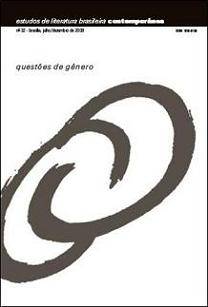Gêneros indefinidos e corpos inadequados revelam ideal feminino inatingível, em Deixei ele lá e vim, de Elvira Vigna
Abstract
Esse trabalho analisa a representação dos corpos na construção da identidade feminina no romance policial Deixei ele lá e vim, de Elvira Vigna. A falta de adequação física das personagens ao modelo ideal de corpo é diretamente relacionada ao fracasso, Ã exclusão social e até Ã morte. O afogamento de Dô é emblemático do conflito gerado pela distância entre a realidade dos corpos femininos e a impossível utopia da mulher moderna. A imposição de um padrão ideal é revelada como uma violência simbólica, que resulta em doenças, disfunções e nos mais diversos tipos de sofrimento físico e psicológico.
Downloads
References
BENTO, Berenice. A reinvenção do corpo: sexualidade e gênero na experiência transexual. Rio de Janeiro: Garamond, 2006.
BOURDIEU, Pierre. A dominação masculina. Rio de Janeiro: Bertand Brasil, 1999.
BUTLER, Judith. Bodies that matter: on the discursive limits of sex. New York: Routledge, 1998.
_______. Problemas de gênero: feminismo e subversão da identidade. Rio de Janeiro: Civilização Brasileira, 2003.
_______. Undoing gender. New York: Routledge, 2004.
DALCASTAGNÈ, Regina. “Vozes nas sombras: representação e legitimidade na narrativa contemporânea”, em _______ (org.). Ver e imaginar o outro: alteridade, desigualdade, violência na literatura brasileira contemporânea. São Paulo: Horizonte, 2008.
FOUCAULT, Michel. História da sexualidade I: a vontade de saber. Rio de Janeiro: Edições Graal, 1988.
LOURO, Guacira Lopes. Um corpo estranho: ensaios sobre sexualidade e teoria queer. Belo Horizonte: Autêntica, 2004.
JAGOSE, Annamarie. Queer theory: an introduction. New York: New York University Press, 1996.
VIGNA, Elvira. Deixei ele lá e vim. São Paulo: Companhia das Letras, 2006.
Downloads
Published
How to Cite
Issue
Section
License
Authors who publish in this journal agree to the following terms:
a) The authors maintain the copyright and grant the journal the right of first publication, the work being simultaneously licensed under the Creative Commons Attribution License-Non Commercial 4.0 which allows the sharing of the work with acknowledgment of the authorship of the work and publication this journal.
b) Authors are authorized to enter into additional contracts separately, for non-exclusive distribution of the version of the work published in this journal (eg publish in institutional repository or as a book chapter), with authorship recognition and publication in this journal.
c) Authors are allowed and encouraged to publish and distribute their work online (eg in institutional repositories or on their personal page) after the editorial process, as this can generate productive changes, as well as increase the impact and citation of published work (See The Effect of Free Access).
d) The authors of the approved works authorize the magazine to, after publication, transfer its content for reproduction in content crawlers, virtual libraries and the like.
e) The authors assume that the texts submitted to the publication are of their original creation, being fully responsible for their content in the event of possible opposition by third parties.


